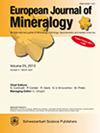fero -ferri- holmquisite,□Li2(Fe2+3Fe3+2)Si8O22(OH)2, Fe2+Fe3+ holmquisite的类似物,产自日本爱母岛Iwagi岛
IF 1.7
3区 地球科学
Q2 MINERALOGY
引用次数: 1
摘要
摘要Ferro-ferri-holmquisite(IMA2022-020),理想配方□Li2(Fe32+Fe23+)Si8O22(OH。它通常以针状聚集体和/或孤立晶体的形式存在于石英、钠长石和钾长石中,呈蓝色,带蓝灰色条纹和玻璃光泽。其莫氏硬度为5 1/2。其解理在{210}上是完美的。测量和计算的密度为Dmeas=3.2 g cm−3和Dcalc=3.317 g cm−3。铁-铁-霍姆奎斯特是光学双轴(-),α=1.685,β=1.713和γ=1.727,并且是异时的,X= 淡蓝色~淡黄蓝色,Y= 深蓝色~棕蓝色和Z= 深蓝色~深蓝色紫色;X> Z>Y。磁化敏感性与伴生黑云母相似。铁-铁-钬不溶于HCl、HNO3和H2SO4。根据∑(C+T)计算的经验公式= 13电子探针分析仪(EPMA)和激光烧蚀电感耦合等离子体质谱仪(LA-ICP-MS)的结果是A(K0.01Na0.06)∑0.07B(Li1.95Na0.04Ca0.01)∑2.00C(Fe2.822+Fe1.393+Al0.51Mg0.22Mn0.052+Ti0.01)∑5.00T(Si7.98Al0.02)∑8.00O22(OH)1.94F0.06。结构精化收敛于R1= 4.22 %. 空间群为正交Pnma,晶胞参数为= 18.5437(2) Å,b= 17.9222(1) Å,c= 5.3123(1) Å和V= 1765.51(1) Å3.根据细化的占据率,结构式可以写成ANa0.062M4(Li1.952Na0.048)∑2.000M1(Fe1.7702+Mg0.230)∑2.000M2(Fe1.4463+Fe0.1022+Al0.452)∑2.000M3(Fe0.8912+Mg0.109)∑1.000TSi8O22(OH)2(Z= 4) 。三个OH伸缩IR带,中心位于3614、3631和3644 cm−1,分配给本地配置M1M1M3= 基于正交Pnma角闪石的红外光谱研究,分别为FeFeFe、MgFeFe(包括FeMgFe和FeFeMg)和MgMgFe(包括MgFeMg和FeMgMg)。本文章由计算机程序翻译,如有差异,请以英文原文为准。
Ferro-ferri-holmquistite, □Li2(Fe2+3Fe3+2)Si8O22(OH)2, Fe2+Fe3+ analogue of holmquistite, from the Iwagi islet, Ehime, Japan
Abstract. Ferro-ferri-holmquistite (IMA2022-020), ideal formula
□Li2(Fe32+Fe23+)Si8O22(OH)2, was
found in albitized granite from the Iwagi islet, Ehime, Japan.
Ferro-ferri-holmquistite is a CFe2+Fe3+ analogue of
holmquistite and belongs to the lithium-subgroup amphiboles. It commonly
occurs as acicular aggregate and/or isolated crystals in quartz, albite and
K-feldspar and is blue with a bluish-grey streak and a vitreous luster. It
has a Mohs hardness of 5 1/2. Its cleavage is perfect on
{210}. Measured and calculated densities are
Dmeas.=3.2 g cm−3 and Dcalc.=3.317 g cm−3,
respectively. Ferro-ferri-holmquistite is optically biaxial (-), with
α=1.685, β=1.713 and γ=1.727, and is
pleochroic, with X= pale blue ∼ pale yellowish blue, Y= deep blue ∼ brownish blue and Z= deep blue ∼ deep bluish violet; X>Z>Y. The magnetic
susceptibility is similar to the associated biotite.
Ferro-ferri-holmquistite is insoluble in HCl, HNO3 and H2SO4.
The empirical formula calculated on the basis of Σ(C+T) = 13 on the results obtained by electron
microprobe analyzer (EPMA), and laser ablation inductively coupled plasma mass spectrometry (LA-ICP-MS) is
A(K0.01Na0.06)Σ0.07B(Li1.95Na0.04Ca0.01)Σ2.00C(Fe2.822+Fe1.393+Al0.51Mg0.22Mn0.052+Ti0.01)Σ5.00T(Si7.98Al0.02)Σ8.00O22(OH)1.94F0.06. Structure refinement converged
to R1= 4.22 %. The space group is orthorhombic Pnma, and the
unit-cell parameters are a= 18.5437(2) Å, b= 17.9222(1) Å, c= 5.3123(1) Å and V= 1765.51(1) Å3. Based on the refined
site occupancies, the structural formula can be written as
ANa0.062M4(Li1.952Na0.048)Σ2.000M1(Fe1.7702+Mg0.230)Σ2.000M2(Fe1.4463+Fe0.1022+Al0.452)Σ2.000M3(Fe0.8912+Mg0.109)Σ1.000TSi8O22(OH)2 (Z= 4). Three OH-stretching IR
bands, centered at 3614, 3631 and 3644 cm−1, are assigned to the local
configuration M1M1M3= FeFeFe, MgFeFe (including FeMgFe and FeFeMg) and
MgMgFe (including MgFeMg and FeMgMg), respectively, based on the IR studies
of the orthorhombic Pnma amphiboles.
求助全文
通过发布文献求助,成功后即可免费获取论文全文。
去求助
来源期刊
CiteScore
2.80
自引率
9.50%
发文量
40
审稿时长
6-12 weeks
期刊介绍:
EJM was founded to reach a large audience on an international scale and also for achieving closer cooperation of European countries in the publication of scientific results. The founding societies have set themselves the task of publishing a journal of the highest standard open to all scientists performing mineralogical research in the widest sense of the term, all over the world. Contributions will therefore be published primarily in English.
EJM publishes original papers, review articles and letters dealing with the mineralogical sciences s.l., primarily mineralogy, petrology, geochemistry, crystallography and ore deposits, but also biomineralogy, environmental, applied and technical mineralogy. Nevertheless, papers in any related field, including cultural heritage, will be considered.

 求助内容:
求助内容: 应助结果提醒方式:
应助结果提醒方式:


